Superior Creep Resistance and Remnant Strength of Novel Tempered Ferritic-Martensitic Steels Designed by Element Addition
Abstract
:1. Introduction
2. Experimental Procedures
3. Results
3.1. Creep Properties
3.2. Tensile Properties after Prior Creep
3.3. Optical Morphologies after Creep
3.4. TEM Microstructures after Creep
3.5. Distribution of Chemical Compositions after Creep
4. Discussion
4.1. Preferential Partitioning of Cr to Cementite/Carbides
4.2. Suppression of Carbide Coarsening
4.3. Enhanced Creep Resistance and Remnant Tensile Strength
5. Conclusions
- (1)
- Unlike the degraded remnant tensile strength in the 0Cr samples, prior creep history in the 1Cr samples enables subsequent tensile yield strength of around ~940 MPa without obvious degradation. When the addition of Cr element is further increased to 13 wt.%, prior creep history enhances remnant tensile strength from ~840 MPa to ~960 MPa with prolonged creep time from 0 h to 96 h.
- (2)
- The coarsening of cementite particles is remarkably retarded in the 1Cr samples after creep in comparison to that in the 0Cr samples. For the 13Cr samples, however, the microstructure undergoes precipitation of carbide particles without the occurrence of coarsening due to a much slower precipitation response.
- (3)
- Cr element is prone to be segregated into the precipitate particles. The cementite in the 0Cr samples is evolved to alloyed cementite when 1 wt.% Cr is added, whereas carbide particles are formed when the addition content is increased to 13 wt.%. The intrinsic thermal stability possessed by both alloyed cementite and carbides continuously favors a precipitation-strength effect, which synchronously slows down the creep rate and enhances remnant tensile strength.
Author Contributions
Funding
Data Availability Statement
Acknowledgments
Conflicts of Interest
References
- Yang, S.; Han, L.; Feng, C.; Wang, H.; Feng, Y.; Wu, X. Mechanical performance of casing in in-situ combustion thermal recovery. J. Pet. Sci. Eng. 2018, 168, 32–38. [Google Scholar] [CrossRef]
- Moore, R.; Laureshen, C.J.; Belgrave, J.D.; Ursenbach, M.G.; Mehta, S. In situ combustion in Canadian heavy oil reservoirs. Fuel 1995, 74, 1169–1175. [Google Scholar] [CrossRef]
- Sarathi, P.S. In-Situ Combustion Handbook-Principles and Practices; National Petroleum Technology Office: Tulsa, OK, USA, 1999.
- Mahinpey, N.; Ambalae, A.; Asghari, K. In situ combustion in enhanced oil recovery (EOR): A review. Chem. Eng. Commun. 2007, 194, 995–1021. [Google Scholar] [CrossRef]
- Turta, A.; Chattopadhyay, S.; Bhattacharya, R.; Condrachi, A.; Hanson, W. Current Status of Commercial In Situ Combustion Projects Worldwide. J. Can. Pet. Technol. 2007, 46, 8–14. [Google Scholar] [CrossRef]
- Wang, H.; Yang, S.; Han, L.; Yu, S.; Ren, S.; Zhang, G. Effect of prior oxidation and creep damages on subsequent tensile properties of low alloy steels. Mater. Res. Express 2019, 6, 116515. [Google Scholar] [CrossRef]
- Choudhuri, D.; Srinivasan, S.G.; Gibson, M.A.; Zheng, Y.; Jaeger, D.L.; Fraser, H.L.; Banerjee, R. Exceptional increase in the creep life of magnesium rare-earth alloys due to localized bond stiffening. Nat. Commun. 2017, 8, 2000. [Google Scholar] [CrossRef] [PubMed]
- Taneike, M.; Abe, F.; Sawada, K. Creep-strengthening of steel at high temperatures using nano-sized carbonitride dispersions. Nature 2003, 424, 294–296. [Google Scholar] [CrossRef]
- Athul, K.R.; Pillai, U.T.S.; Srinivasan, A.; Pai, B.C. A Review of Different Creep Mechanisms in Mg Alloys Based on Stress Exponent and Activation Energy. Adv. Eng. Mater. 2015, 18, 770–794. [Google Scholar] [CrossRef]
- Vagarali, S.S.; Langdon, T.G. Deformation mechanisms in hcp metals at elevated temperatures—I. Creep behavior of magnesium. Acta Metall. 1981, 29, 1969–1982. [Google Scholar] [CrossRef]
- Vagarali, S.S.; Langdon, T.G. Deformation mechanisms in hcp metals at elevated temperatures—II. Creep behavior of a Mg-0.8% Al solid solution alloy. Acta Metall. 1982, 30, 1157–1170. [Google Scholar] [CrossRef]
- Chen, G.; Peng, Y.; Zheng, G.; Qi, Z.; Wang, M.; Yu, H.; Dong, C.; Liu, C.T. Polysynthetic twinned TiAl single crystals for high-temperature applications. Nat. Mater. 2016, 15, 876–881. [Google Scholar] [CrossRef] [PubMed]
- Gao, Y.H.; Guan, P.F.; Su, R.; Chen, H.W.; Yang, C.; He, C.; Cao, L.F.; Song, H.; Zhang, J.Y.; Zhang, X.; et al. Segregation-sandwiched stable interface suffocates nanoprecipitate coarsening to elevate creep resistance. Mater. Res. Lett. 2020, 8, 446–453. [Google Scholar] [CrossRef]
- Yamamoto, Y.; Brady, M.P.; Lu, Z.P.; Maziasz, P.J.; Liu, C.T.; Pint, B.A.; More, K.L.; Meyer, H.; Payzant, E.A. Creep-resistant, Al2O3-forming austenitic stainless steels. Science 2007, 316, 433–436. [Google Scholar] [CrossRef] [PubMed]
- Sun, L.; Simm, T.; Martin, T.; McAdam, S.; Galvin, D.; Perkins, K.; Bagot, P.; Moody, M.; Ooi, S.; Hill, P. A novel ultra-high strength maraging steel with balanced ductility and creep resistance achieved by nanoscale β-NiAl and Laves phase precipitates. Acta Mater. 2018, 149, 285–301. [Google Scholar] [CrossRef] [Green Version]
- Fournier, B.; Dalle, F.; Sauzay, M.; Longour, J.; Salvi, M.; Caës, C.; Tournié, I.; Giroux, P.F.; Kim, S.H. Comparison of various 9–12%Cr steels under fatigue and creep-fatigue loadings at high temperature. Mater. Sci. Eng. A 2011, 528, 6934–6945. [Google Scholar] [CrossRef]
- Fedorova, I.; Belyakov, A.; Kozlov, P.; Skorobogatykh, V.; Shenkova, I.; Kaibyshev, R. Laves-phase precipitates in a low-carbon 9% Cr martensitic steel during aging and creep at 923 K. Mater. Sci. Eng. A 2014, 615, 153–163. [Google Scholar] [CrossRef]
- Orlová, A.; Buršík, J.; Kuchařová, K.; Sklenička, V. Microstructural development during high temperature creep of 9% Cr steel. Mater. Sci. Eng. A 1998, 245, 39–48. [Google Scholar] [CrossRef]
- Vanaja, J.; Laha, K.; Mythili, R.; Chandravathi, K.S.; Saroja, S.; Mathew, M.D. Creep deformation and rupture behaviour of 9Cr–1W–0.2V–0.06Ta Reduced Activation Ferritic–Martensitic steel. Mater. Sci. Eng. A 2012, 533, 17–25. [Google Scholar] [CrossRef]
- Baik, S.-I.; Rawlings, M.J.; Dunand, D.C. Effect of hafnium micro-addition on precipitate microstructure and creep properties of a Fe-Ni-Al-Cr-Ti ferritic superalloy. Acta Mater. 2018, 153, 126–135. [Google Scholar] [CrossRef]
- Callister, W.D.; Rethwisch, D.G. Materials Science and Engineering: An Introduction; Wiley: New York, NY, USA, 2018. [Google Scholar]
- Abe, F.; Kern, T.-U.; Viswanathan, R. Creep-Resistant Steels; Elsevier: Amsterdam, The Netherlands, 2008. [Google Scholar]
- Aghajani, A.; Somsen, C.; Eggeler, G. On the effect of long-term creep on the microstructure of a 12% chromium tempered martensite ferritic steel. Acta Mater. 2009, 57, 5093–5106. [Google Scholar] [CrossRef]
- Liao, H.; Guan, Z.; Feng, G.; Yan, Z. Casing failure mechanism and strength design considerations for deep and ultra-deep wells. Oil Drill. Prod. Technol. 2009, 31, 1–4. [Google Scholar]
- Zhou, X.; He, S.; Tang, M.; Fang, L.; Zhou, X.; Liu, Z. Mechanism of collapse failure and analysis of yield collapse resistance of casing under combined load. Eng. Struct. 2019, 191, 12–22. [Google Scholar] [CrossRef]
- Zhang, W.; Wang, X.; Chen, H.; Zhang, T.; Gong, J. Evaluation of the effect of various prior creep-fatigue interaction damages on subsequent tensile and creep properties of 9%Cr steel. Int. J. Fatigue 2019, 125, 440–453. [Google Scholar] [CrossRef]
- Mariappan, K.; Shankar, V.; Sandhya, R.; Mathew, M.D.; Bhaduri, A.K. Influence of Prior Fatigue Damage on Tensile Properties of 316L(N) Stainless Steel and Modified 9Cr-1Mo Steel. Metall. Mater. Trans. A 2014, 46, 989–1003. [Google Scholar] [CrossRef]
- Mariappan, K.; Shankar, V.; Sandhya, R.; Bhaduri, A.; Laha, K. Comparative assessment of remnant tensile properties of modified 9Cr-1Mo steel under prior low cycle fatigue and creep-fatigue interaction loading. Int. J. Fatigue 2017, 103, 342–352. [Google Scholar] [CrossRef]
- Sánchez-Santana, U.; Mesmacque, G.; Decoopman, X.; Rubio-González, C.; Amrouche, A. Dynamic tensile behavior of materials with previous fatigue damage. Mater. Sci. Eng. A 2008, 497, 51–60. [Google Scholar] [CrossRef]
- Devaraj, A.; Nag, S.; Srinivasan, R.; Williams, R.; Banerjee, S.; Fraser, H. Experimental evidence of concurrent compositional and structural instabilities leading to ω precipitation in titanium–molybdenum alloys. Acta Mater. 2011, 60, 596–609. [Google Scholar] [CrossRef]
- Porter, D.; Easterling, K. Phase Transformations in Metals and Alloys; Chapman and Hall: London, UK, 1992. [Google Scholar]
- Wu, Y.X.; Sun, W.W.; Gao, X.; Styles, M.J.; Arlazarov, A.; Hutchinson, C.R. The effect of alloying elements on cementite coarsening during martensite tempering. Acta Mater. 2020, 183, 418–437. [Google Scholar] [CrossRef]
- Kunitake, T. On the Concentrating Process of the Alloying Element into Cementite During the Tempering of Steel. J. Jpn. Inst. Met. 1966, 30, 481–487. [Google Scholar] [CrossRef] [Green Version]
- Mortlock, A. The effect of segregation on the solute diffusion enhancement due to the presence of dislocations. Acta Metall. 1960, 8, 132–134. [Google Scholar] [CrossRef]
- Armaki, H.G.; Chen, R.; Kano, S.; Maruyama, K.; Hasegawa, Y.; Igarashi, M. Strain-induced coarsening of nanoscale precipitates in strength enhanced high Cr ferritic steels. Mater. Sci. Eng. A 2012, 532, 373–380. [Google Scholar] [CrossRef]
- Xiao, B.; Xu, L.; Cayron, C.; Xue, J.; Sha, G.; Logé, R. Solute-dislocation interactions and creep-enhanced Cu precipitation in a novel ferritic-martensitic steel. Acta Mater. 2020, 195, 199–208. [Google Scholar] [CrossRef]
- Lv, Z.; Sun, S.; Wang, Z.; Qv, M.; Jiang, P.; Fu, W. Effect of alloying elements addition on coarsening behavior of pearlitic cementite particles after severe cold rolling and annealing. Mater. Sci. Eng. A 2008, 489, 107–112. [Google Scholar] [CrossRef]
- Lv, Z.; Fu, W.; Sun, S.; Bai, X.; Gao, Y.; Wang, Z.; Jiang, P. First-principles study on the electronic structure, magnetic properties and phase stability of alloyed cementite with Cr or Mn. J. Magn. Magn. Mater. 2011, 323, 915–919. [Google Scholar] [CrossRef]
- Gao, Y.H.; Yang, C.; Zhang, J.Y.; Cao, L.F.; Liu, G.; Sun, J.; Ma, E. Stabilizing nanoprecipitates in Al-Cu alloys for creep resistance at 300 °C. Mater. Res. Lett. 2018, 7, 18–25. [Google Scholar] [CrossRef]
- Kostka, A.; Tak, K.; Hellmig, R.; Estrin, Y.; Eggeler, G. On the contribution of carbides and micrograin boundaries to the creep strength of tempered martensite ferritic steels. Acta Mater. 2007, 55, 539–550. [Google Scholar] [CrossRef]
- Hull, D.; Bacon, D.J. Introduction to Dislocations, 5th ed.; Elsevier: Oxford, UK, 2011. [Google Scholar]
- Argon, A.S. Strengthening Mechanisms in Crystal Plasticity; Oxford University Press Inc.: New York, NY, USA, 2008. [Google Scholar]
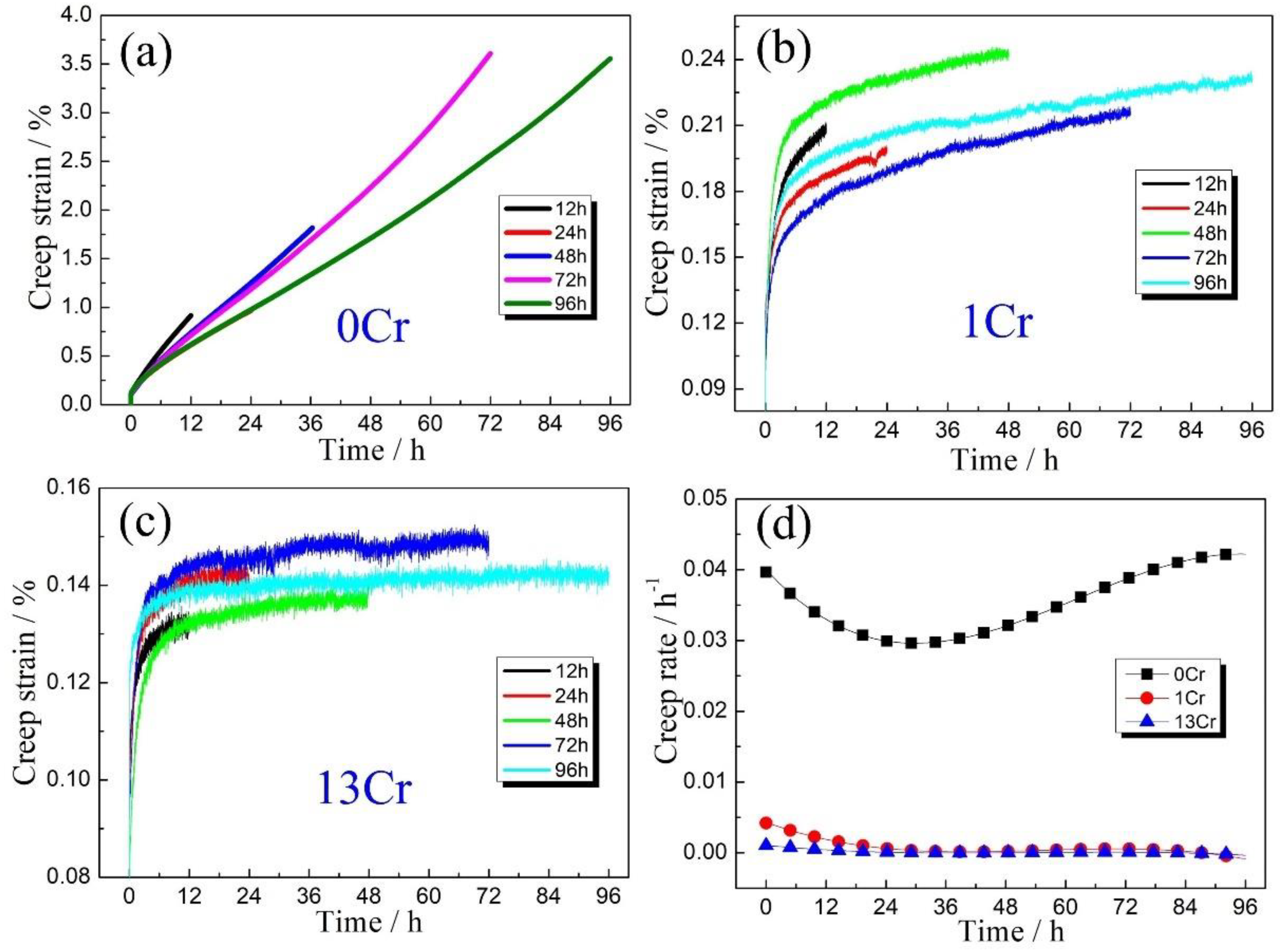
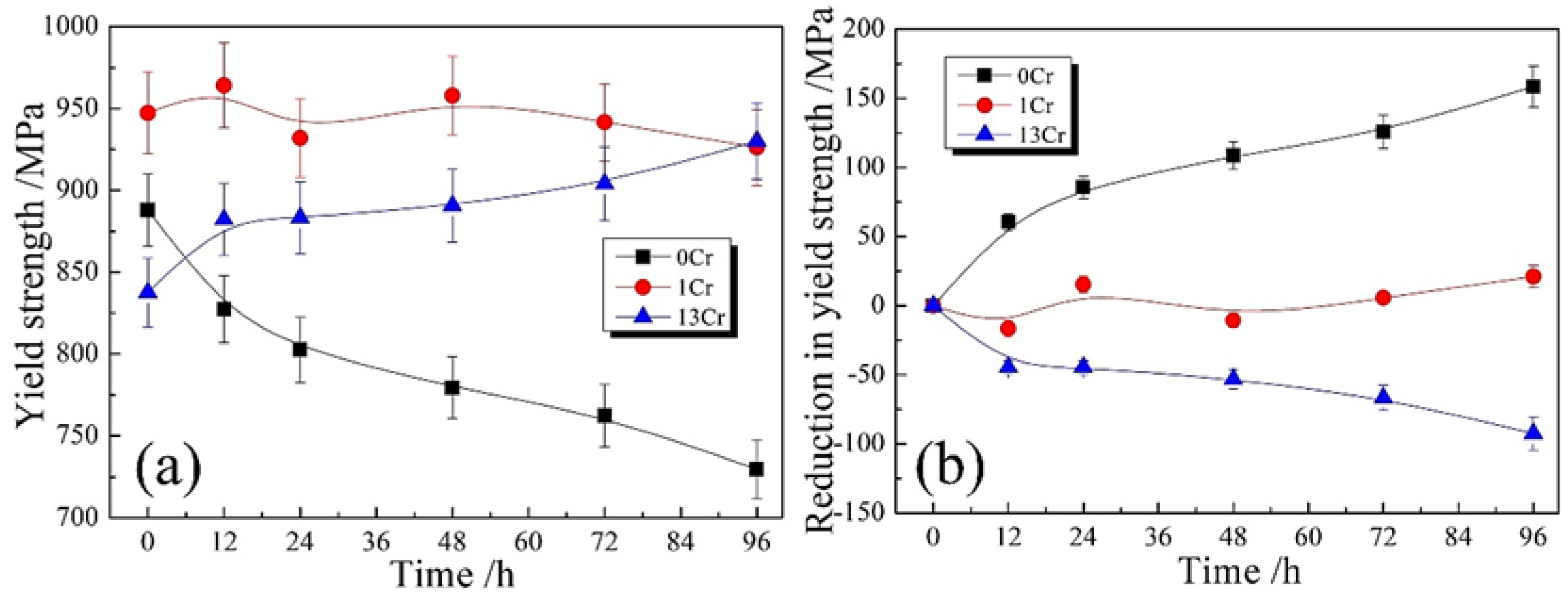
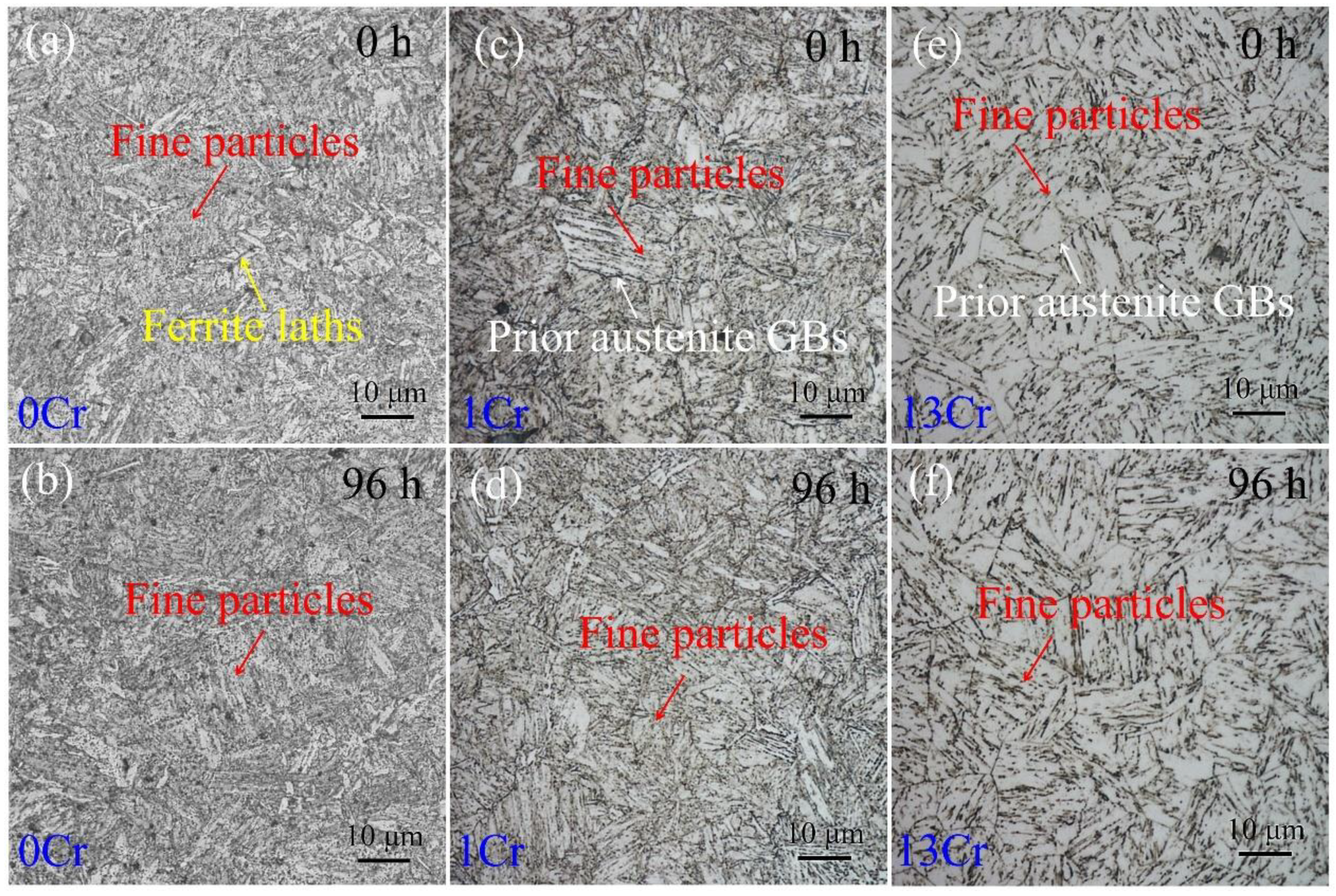

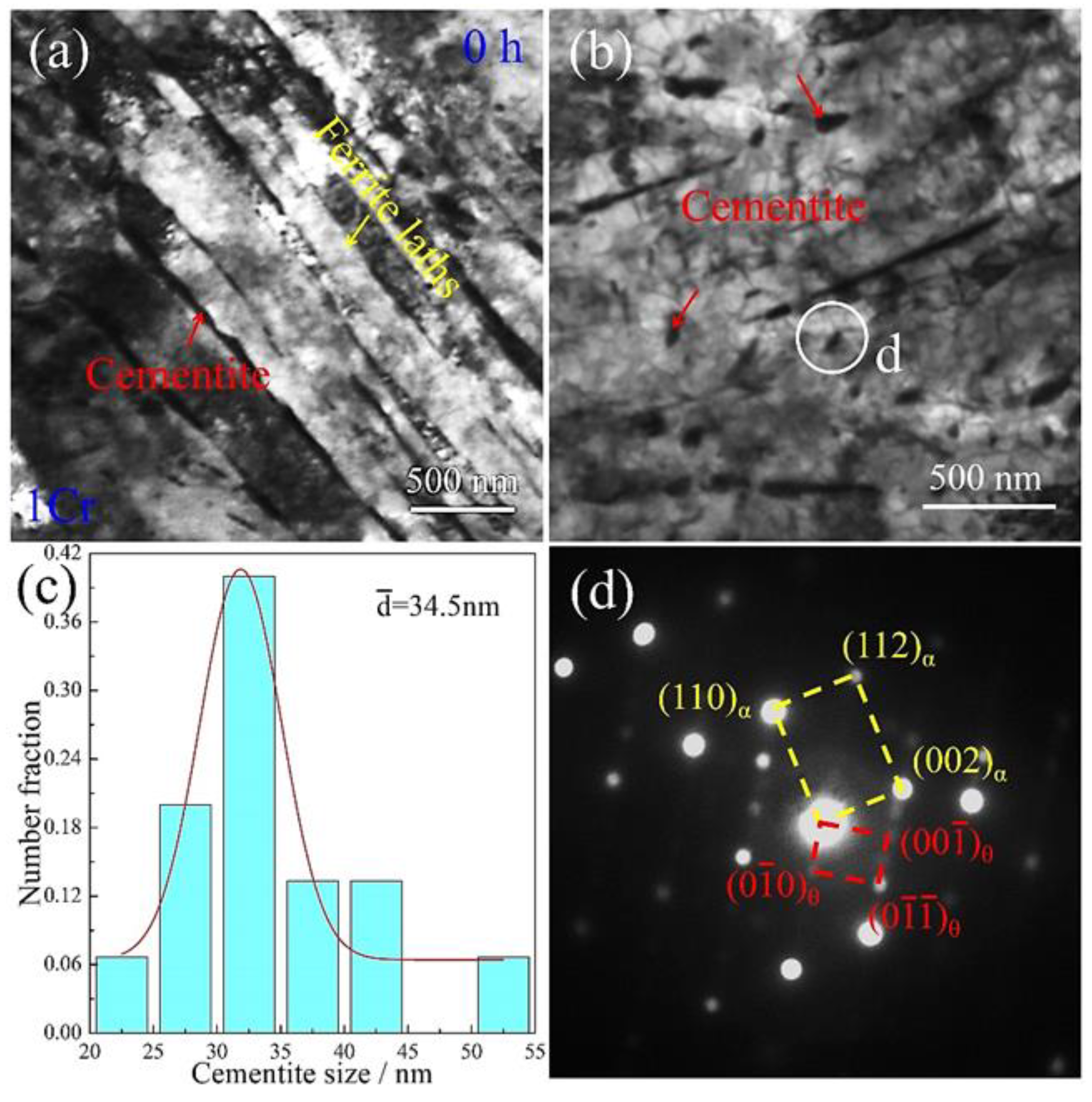
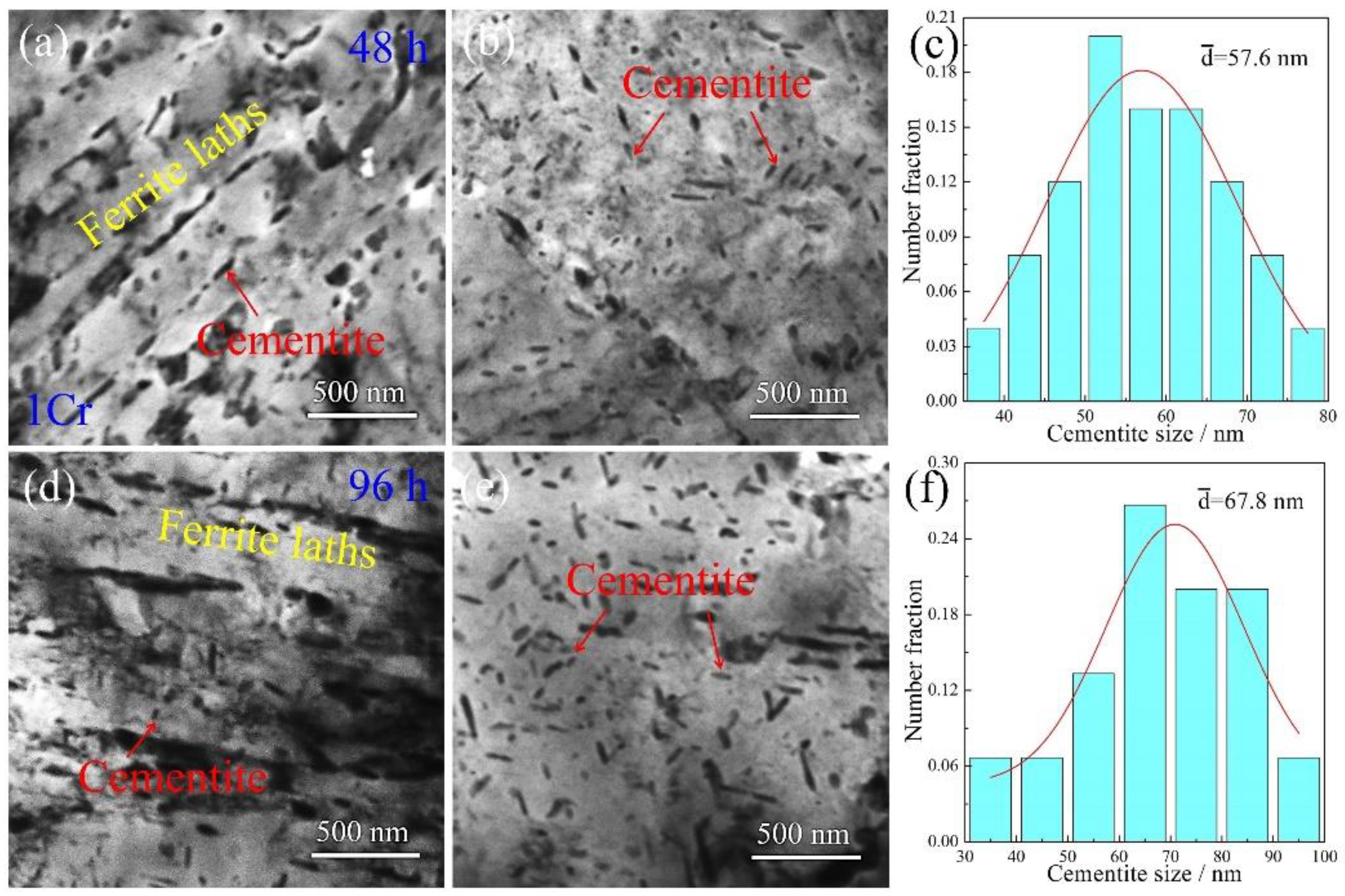
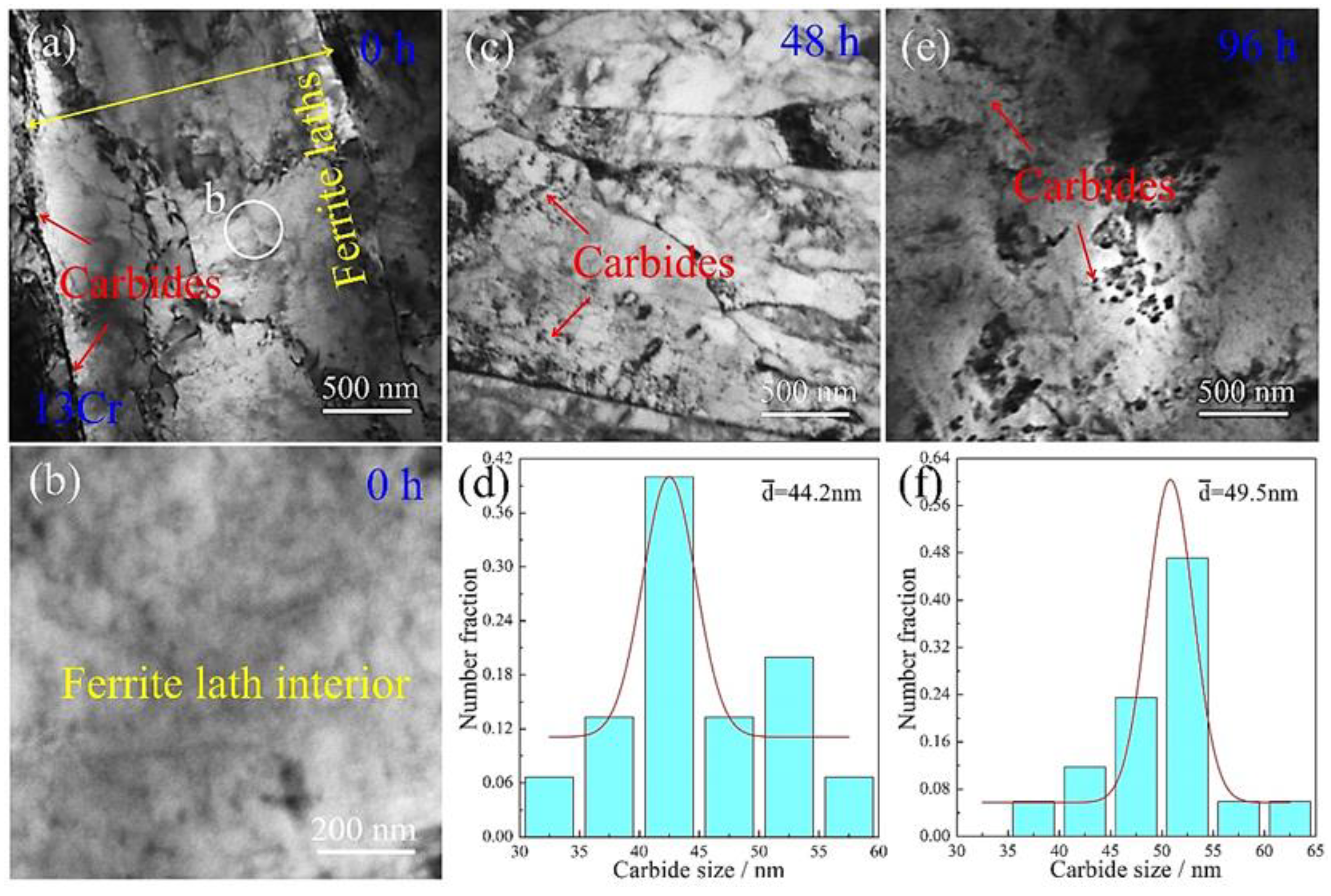
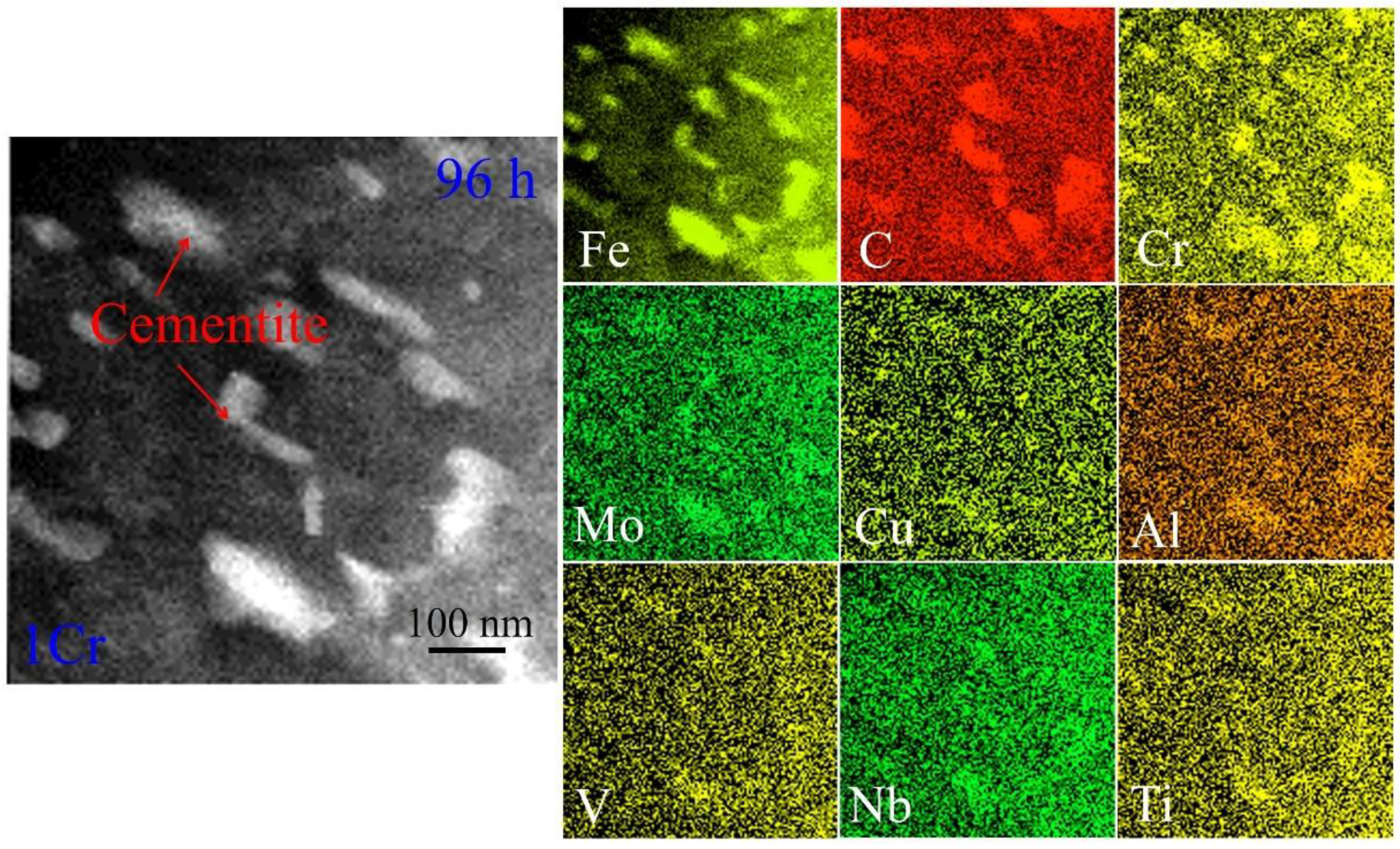
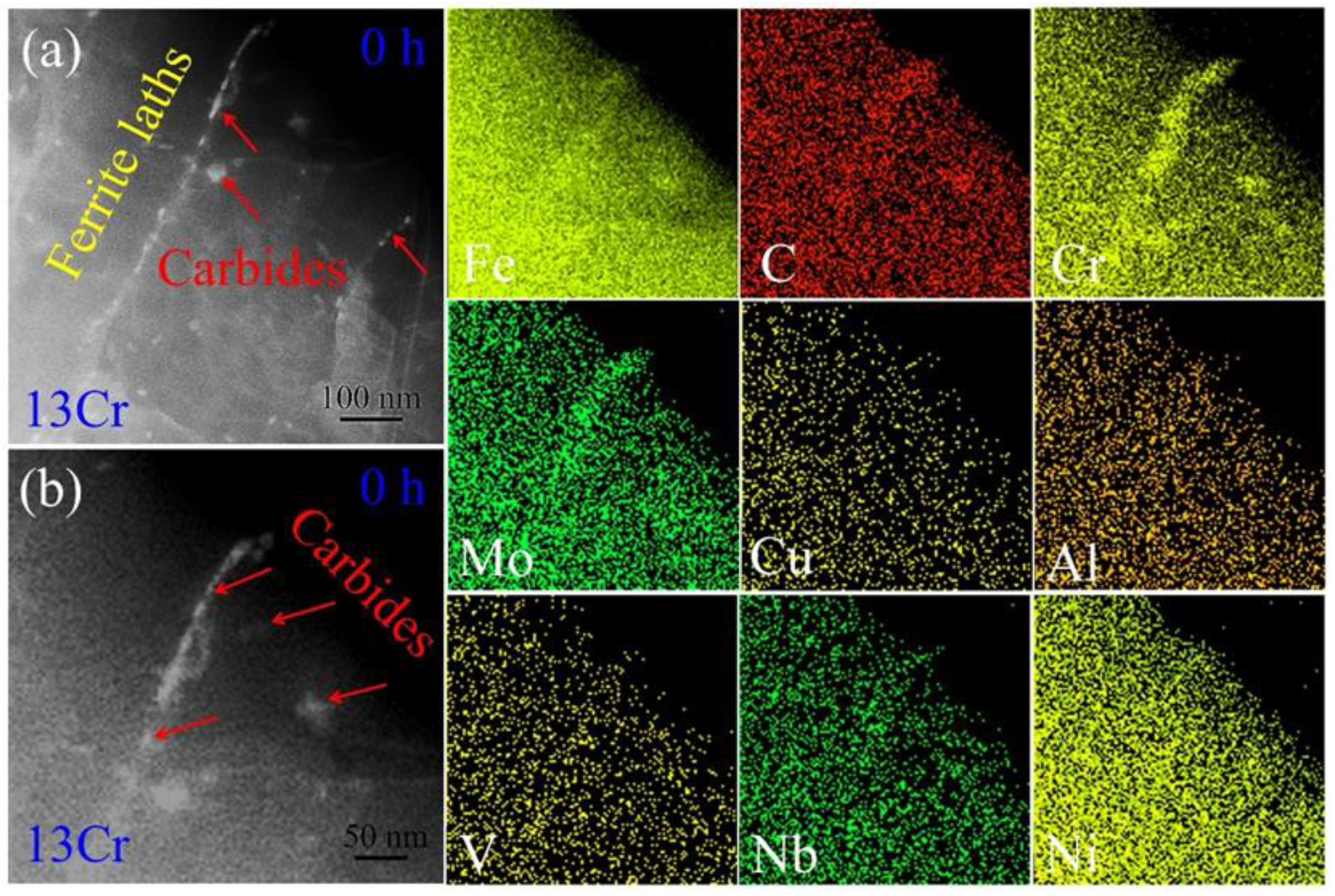

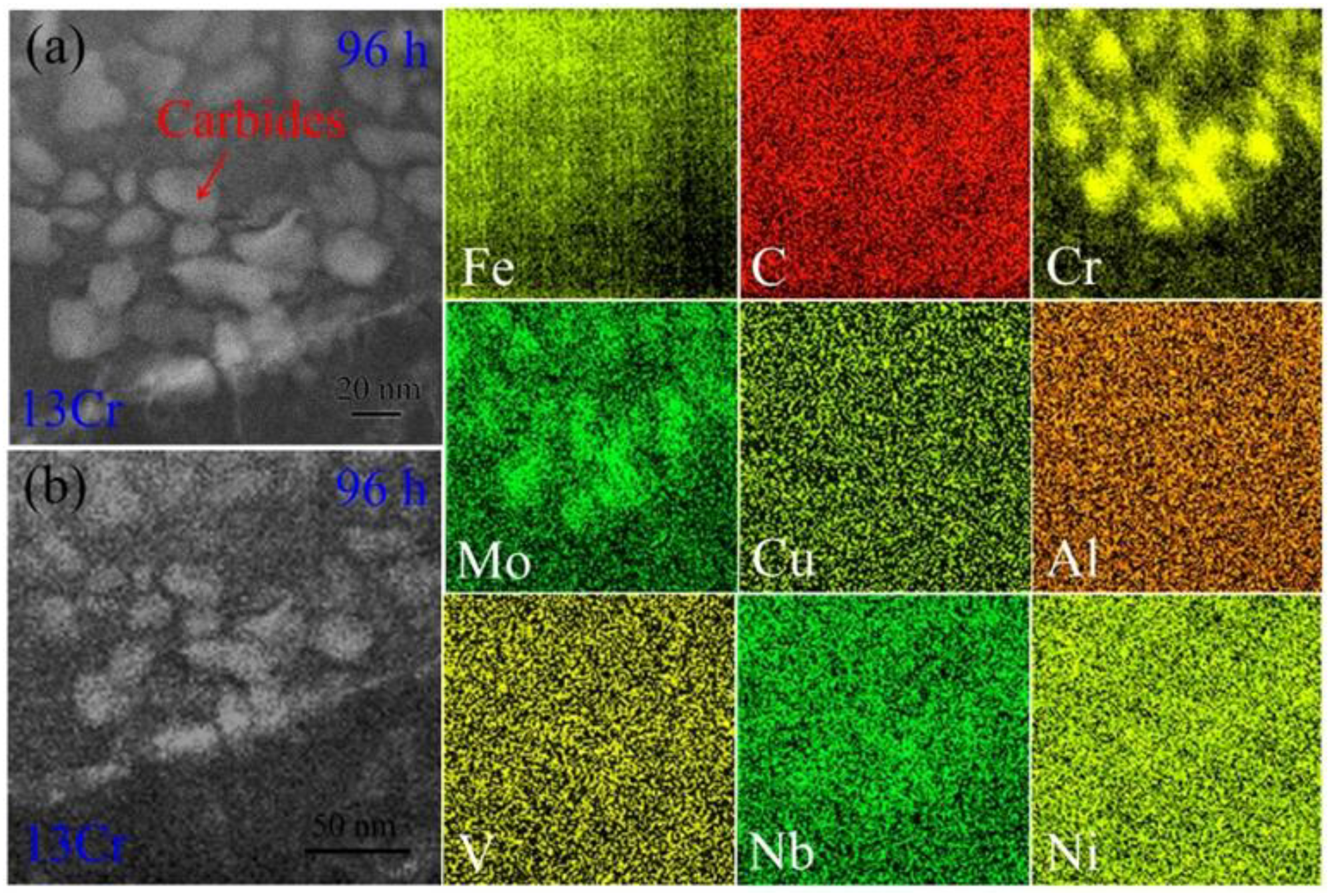
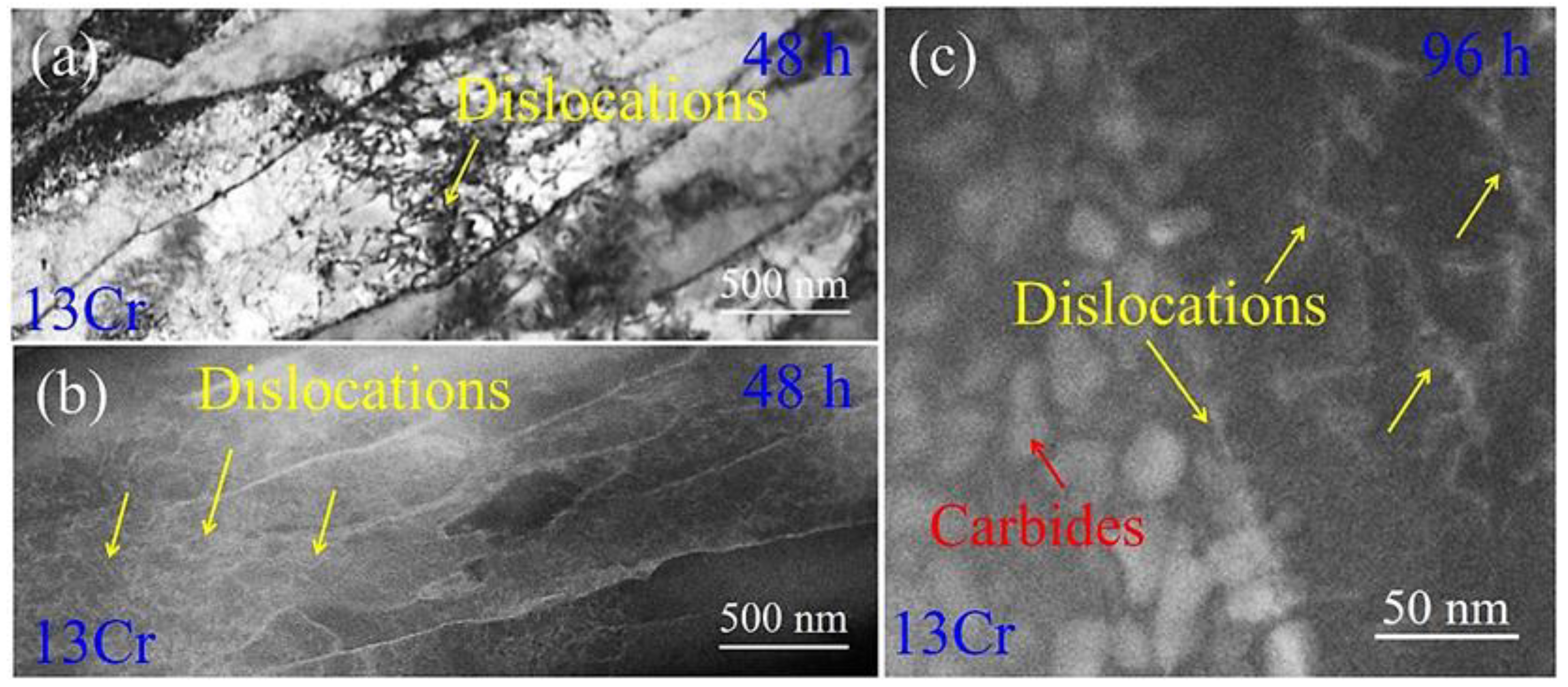
| C | Si | Mn | P | S | Cr | Mo | Ni | Nb V Ti | Cu | Al | |
|---|---|---|---|---|---|---|---|---|---|---|---|
| 0Cr | 0.26 | 0.24 | 1.27 | 0.015 | 0.0018 | 0.042 | 0.008 | 0.020 | ≤0.0079 | 0.053 | 0.016 |
| 1Cr | 0.17 | 0.24 | 0.98 | 0.011 | 0.0034 | 0.99 | 0.33 | 0.059 | 0.019/0.029/0.013 | 0.21 | 0.017 |
| 13Cr | 0.26 | 0.19 | 0.17 | 0.011 | 0.0002 | 12.4 | 2.04 | 5.6 | 0.0001/0.013/0.0002 | 0.06 | 0.033 |
Publisher’s Note: MDPI stays neutral with regard to jurisdictional claims in published maps and institutional affiliations. |
© 2022 by the authors. Licensee MDPI, Basel, Switzerland. This article is an open access article distributed under the terms and conditions of the Creative Commons Attribution (CC BY) license (https://creativecommons.org/licenses/by/4.0/).
Share and Cite
Wang, H.; Li, K.; Chen, W.; Han, L.; Feng, Y. Superior Creep Resistance and Remnant Strength of Novel Tempered Ferritic-Martensitic Steels Designed by Element Addition. Materials 2022, 15, 3327. https://doi.org/10.3390/ma15093327
Wang H, Li K, Chen W, Han L, Feng Y. Superior Creep Resistance and Remnant Strength of Novel Tempered Ferritic-Martensitic Steels Designed by Element Addition. Materials. 2022; 15(9):3327. https://doi.org/10.3390/ma15093327
Chicago/Turabian StyleWang, Hang, Keer Li, Wei Chen, Lihong Han, and Yaorong Feng. 2022. "Superior Creep Resistance and Remnant Strength of Novel Tempered Ferritic-Martensitic Steels Designed by Element Addition" Materials 15, no. 9: 3327. https://doi.org/10.3390/ma15093327






